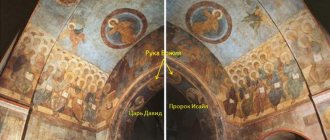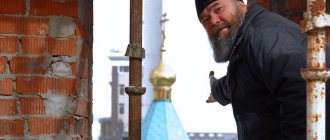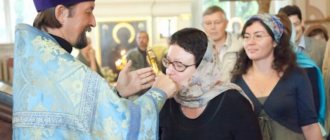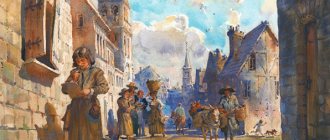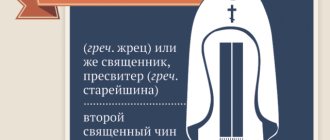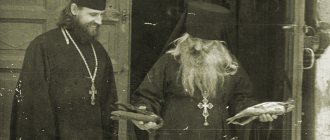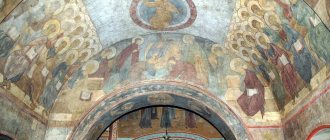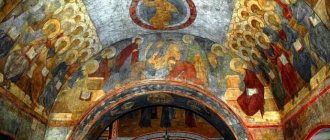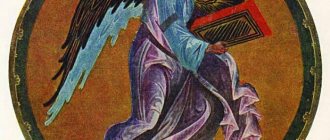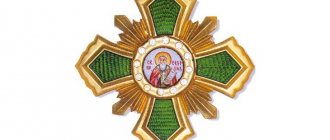January 1, 1370 – October 17, 1428 (58 years old)
4.3
Average rating: 4.3
Total ratings received: 98.
Andrei Rublev (circa 1360–1428) is an outstanding Russian icon painter, one of the brightest representatives of the Moscow school of icon painting, monumental and book painting of the 15th century. Rublev's frescoes and icons, which accurately convey the essence of the Orthodox religion, are a heritage of Russian and world culture. Andrei Rublev, whose biography is the personification of sincere service to God, was canonized as a saint.
The material was prepared jointly with a teacher of the highest category, Ekaterina Valerievna Alexandrova.
Experience as a history and social studies teacher - 11 years.
Biography
For the Russian people and world Orthodoxy, the icon painter Andrei Rublev became a symbol of art and a certain standard of the Russian person, the greatness of the Slavic spirit. The master’s icons and frescoes breathe harmony with the universe, reminiscent of a lost paradise, happiness and serenity.
Icon painter Andrei Rublev
Fans compare the icon painter’s work with the poetry of Alexander Pushkin. It is just as thorough, eternal and brilliant. Peering into the faces of the Rublev saints, you see self-sacrifice, beauty and greatness of man. Andrei Rublev understood the essence and spirit of faith in God, so the Russian Orthodox Church canonized the icon painter, canonizing him among the reverend saints.
Childhood and youth
The icon painter was allegedly born in 1360 on the territory of the Moscow Principality (other sources indicate Veliky Novgorod as Rublev’s birthplace). Information about the artist’s childhood, youth and family is extremely scarce. Historians and art historians, based on the surname Rublev, have suggested that Andrei’s ancestors on his father’s side are artisans.
Monument to Andrey Rublev
The name Andrei Rublev was given after his monastic tonsure in a monastery on the left bank of the Yauza, known to us as Andronikov. The worldly name of the artist is not known. Researchers agreed that Andrei Rublev’s patronymic was Ivanovich: on the surviving icon of that time, they could discern the signature “Andrei Ivanov son Rublev.”
Film about Andrei Rublev
There are still many black spots in the biography of Andrei Rublev. In fact, very little is known about him, except two mentions in historical sources. Researchers even date the painting of his famous Trinity icon to two different years: 1411 or 1425-1427.
One of the ways to tell the world about this talented person, about the era in which he lived, about his creative searches and development as an artist was a narrative film made in the 60s of the 20th century by the famous director A. Tarkovsky. In several short stories, the film paints pictures of medieval Rus', briefly tells about the biography of Andrei Rublev, about his worldviews and doubts, about his vow of silence, which he observed for 15 years, and other interesting facts from the life of the icon painter.
Iconography
The biography of the saint dates back to 1405 - this is the year of the first written mention of Andrei Rublev. The chronicle says that the monk Rublev, together with Theophan the Greek who arrived from Kafa and Prokhor the Elder, painted the walls of the Annunciation Cathedral in the Moscow Kremlin. Collaboration with icon painting luminaries was entrusted to the artist whose skill was not questioned. Art historians suggest that already in his youth Andrei Rublev had experience in Slavic artistic icon painting.
Icon of Andrei Rublev
Working in tandem with Feofan, whose style of writing is called pictorial cursive for its precise and clear strokes, was an honor for the young master. The Greek icons amaze with their grandeur; the faces of the saints he depicts are stern and brilliant in every stroke. But having adopted the best in technology, Andrei Rublev developed his own style of icon painting, which does not contain the drama and severity of Theophan the Greek. Rublev's icons are filled with calm, clarity and harmony. Art critics point to the artist’s palette, as if inspired by a sunny summer day: here are golden fields with cornflower blue splashes, a scarlet dawn and a turquoise river.
Fresco by Andrei Rublev “Transfiguration of the Lord”
The painting of the Annunciation Cathedral has been lost, but seven icons have been preserved in the cathedral iconostasis, which are attributed to the brushes of Andrei Rublev. It is believed that the artist painted the figures of the Apostle Peter and the Archangel Michael. His hand is recognized in the images of the martyrs Dmitry and George, as well as in icons dedicated to the main events of the Christian Church. The work of Andrei Rublev is called the fresco “Transfiguration”, where the “Rublev” palette is easily recognizable. The silhouette of Jesus is inscribed in a circle, the apostles are located in a semicircle. Andrei Rublev considered the circle to be an ideal geometric figure; the circle is found in the works of the last decade.
Icon of Andrei Rublev
At the beginning of the 15th century, Andrei Rublev, together with his comrade-in-arms Daniil Cherny, painted the Assumption Cathedral near Zvenigorod. Probably, the icon painter received an invitation from the godson of Sergius of Radonezh, Prince Yuri of Zvenigorod. In the surviving frescoes, Rublev's technique is evident, but his brushes most likely belonged only to images of saints Florus and Laurus. The remaining icons were painted by artel artists, whose style was influenced by the work of Andrei Rublev. The icon painter’s works include three frescoes of the “Zvenigorod rank”.
Andrei Rublev and Sergius of Radonezh
The icon “Spas” embodied a new tradition, which marked the golden age of the heyday of Russian icon painting. The early works of Andrei Rublev include illustrations for the “Gospel of Khitrov”. The artist painted miniatures of the evangelists and their symbols. The miniature of an angel, a symbol of the Evangelist Matthew, is mesmerizing. The “Rublev” circle is encountered again, in the center of which is a walking winged young man. The composition seems to push the idea of returning everything to normal. The miniatures for the “Gospel of Khitrov” echo the Byzantine tradition, but Andrei Rublev’s saints differ from the images of the Greeks in a certain spiritual calm, depth in spiritual life and detachment from the external.
Illustration by Andrei Rublev for “The Gospel of Khitrov”
The second written mention of the master dates back to 1408. It talks about the beginning of painting by Andrei Rublev and Daniil Cherny of the Vladimir Church. The masters painted the Assumption Cathedral, built before the invasion of the Mongol horde. Frescoes of the Last Judgment of Rublev and Cherny were placed in the western part of the temple, on its vaults. This master’s work is the most famous of Vladimir’s. The images are not disparate canvases, but a single whole. Most researchers agree that the “Vladimir Mother of God” belongs to the master’s brush.
Fresco by Andrei Rublev “The Last Judgment”
The Prophet Daniel with an angel pointing to the fresco of the Last Judgment, the righteous led by the Apostle Peter to heaven, trumpeting angels - in the Apocalypse of Andrei Rublev there is no edification and the desire to frighten, characteristic of Byzantine icon painters. Rublevsky's Last Judgment is more merciful; it gives hope for deliverance. At the end of 1408, the Tatar horde of Khan Edigei moved to Rus'. The army destroyed Serpukhov, Pereslavl, Nizhny Novgorod and Rostov, and approached Moscow. The Trinity Monastery was destroyed, and in 1410 the Tatars attacked Vladimir, destroying the Assumption Cathedral.
Andrei Rublev paints the Spassky Cathedral
Traces of the icon painter are lost; nothing is heard of him for two decades. Perhaps during these difficult times for Rus', Andrei Rublev took refuge in the Andronikov Monastery. The restoration of the Trinity-Sergius Monastery began in 1422. The third mention of the master dates back to this period. Above the tomb of Sergius of Radonezh, instead of a burnt wooden one, a stone temple appeared. Abbot Nikon invited Andrei Rublev to paint it. The master created an icon in the Trinity Cathedral, which art critics call a masterpiece and the pinnacle of Rublev’s creative heritage.
Icon of Andrei Rublev “Trinity”
The famous “Trinity” amazes with the perfection of its composition. And again Andrei Rublev resorts to the circle created by the figures of angels bent over the bowl. Art historians agree that the icons “Savior”, “Apostle Paul” and “Archangel Michael” belonging to the “Zvenigorod rite” belong to the brushes of Andrei Rublev. They are kept in the State Tretyakov Gallery. Other icons and frescoes attributed to Rublev are called by researchers the work of an artel or Rublev's contemporaries who copied his style.
Interesting facts from the life of the artist
In the terrible times of wars and strife in the 14th–15th centuries, the great icon painter Andrei Rublev appeared in Rus'.
The idea of Rublev as a man of kind, humble disposition, “full of joy and lightness,” has been preserved.
He was characterized by great internal concentration. Everything he created is the fruit of deep thought. Those around him were amazed that Rublev spent a long time carefully studying the creations of his predecessors, treating the icon as a work of art.
Although Rublev's name was mentioned in chronicles in connection with the construction of various churches, he became known as an artist only at the beginning of the twentieth century after the restoration in 1904 of the Trinity, the main shrine of the Trinity-Sergius Lavra, the most perfect work of ancient Russian painting. After clearing this icon, it became clear why the Stoglavy Cathedral decided to paint this image only the way Rublev painted it. Only then did the search for other works by the artist begin.
During the Battle of Kulikovo in 1380, Rublev was already part of the princely artel of craftsmen, which moved from city to city and was engaged in the construction and decoration of churches. At that time, many churches were being built in Rus', and icon painters had to work in each of them.
It is impossible to consistently trace Rublev's creative path, because ancient Russian icon painters never signed or dated their works.
, , ,
If you find any inaccuracies or would like to add to this article, please send us information to [email protected] , we and our readers will be very grateful to you.
Death and memory
The icon painter died in the late autumn of 1428 from the plague epidemic that was raging in Moscow. Death overtook Andrei Rublev in the Andronikov Monastery, where in the spring he, together with Daniil Cherny, worked on his fourth work - the frescoes of the Spassky Cathedral (they have not survived). Soon after the icon painter his faithful colleague and friend left. According to legend, before his death Andrei Rublev appeared to Daniil Cherny, “in joy calling him to heaven.” To Daniel, Andrei’s appearance seemed joyful and bright.
Monument to Andrey Rublev
The icon painter was buried near the bell tower of the Spassky Cathedral. In 1988, the artist was canonized and canonized, establishing July 17 as his memorial day. In the mid-1990s, archaeologists discovered the ancient throne of the Spassky Cathedral, and next to it the relics. They were attributed to the famous master, but the statement was soon recognized as erroneous.
Central Museum of Ancient Russian Culture and Art named after Andrei Rublev
Researchers call the generally accepted date of the artist’s death erroneous, claiming that Andrei Rublev died at the end of January 1430. Architect P. D. Baranovsky insists on the date January 29, 1430. The architect assured that it was precisely this that was carved on Rublev’s tombstone before it was lost. The Andrei Rublev Museum of Ancient Russian Art was built on this site, the founder of which was the architect Pyotr Baranovsky.
In the late 1940s, a reserve appeared in the Spaso-Andronikov Monastery. The great Rublev is also remembered in Vladimir: a monument to the icon painter stands at the entrance to the park named after A.S. Pushkin. A crater on Mercury was named in honor of the saint, a series of commemorative coins and a postage stamp were issued. In 1966, the film drama “Andrei Rublev” was shot at the Mosfilm film studio by director Andrei Tarkovsky. The original title of the painting, “The Passion of Andrew,” was abandoned. The film consists of eight short stories, in which the turmoil of the Middle Ages is described through the eyes of the monk Andrei Rublev. The artist was played by actor Anatoly Solonitsyn.
Murals of the Holy Trinity Cathedral
At this time, the Tatar Khan Edygei gathered an army and marched on Moscow, which he could not take. However, along the way, the Tatars set fire to many settlements and cities, and were unable to save the Trinity Monastery, where Abbot Nikon served during these years. In subsequent years, Nikon made every effort to restore the monastery, and in 1424 he took on the construction of a white stone church, to which D. Cherny and A. Rublev were invited to create paintings. All works in this temple are dated 1425-1427.
At the same time, the most famous icon in the biography of Andrei Rublev, “Trinity,” was painted. It was part of the iconostasis of the Trinity Cathedral in Sergiev Posad and is considered the most artistically perfect among the icon paintings of that time. The artist reflected in it the concept of the Orthodox religion about the trinity of God.
The history of the discovery of this icon is very interesting: for several centuries it was on public display, but it was not noticed. It so happened that in 1575, Tsar Ivan the Terrible ordered it to be covered with a frame of gold, and only faces, feet and hands were visible. Then, in 1600, Boris Godunov changed the salary to a new, even more luxurious one. During replacement, the icon was covered with drying oil for preservation, which made the colors brighter. Over time, the outer layer began to darken, soot from candles settled on it, and smoke from incense entered it. To make the icon look better, it was constantly updated by applying layers of paint on top along the contours of the design, and then again covered with drying oil. Most likely, the icon would have perished over time if not for chance. At the beginning of the 20th century, restorers scraped off the upper layers with a scalpel, and the beautiful creation of the great icon painter was revealed to their eyes.
Among the frescoes of the Trinity Cathedral that have survived to this day, according to art historians, the hand of A. Rublev includes “Baptism”, “Archangel Michael” and “Apostle Paul”. In color and depth of content, in beauty and color scheme, they resemble the “Trinity”.
Icons and frescoes
- Archangel Michael from the Deesis rank, 1414
- Ascension of the Lord, 1408
- Apostle Paul from the Deesis rank, 1410s. State Tretyakov Gallery (TtG)
- Savior in power, 1408
- Spas, 1410s
- Descent into Hell, 1408-1410. Tretyakov Gallery
- Nativity. Annunciation Cathedral of the Moscow Kremlin
- Archangel Michael, 1408. Cycle of icons of the Deesis tier of the iconostasis of the Assumption Cathedral in Vladimir
- Archangel Gabriel, 1408. Cycle of icons of the Deesis tier of the iconostasis of the Assumption Cathedral in Vladimir
- Our Lady, 1408. Cycle of icons of the Deesis tier of the iconostasis of the Assumption Cathedral in Vladimir
- Gregory the Theologian, 1408. Cycle of icons of the Deesis tier of the iconostasis of the Assumption Cathedral in Vladimir
- John Chrysostom, 1408. Cycle of icons of the Deesis tier of the iconostasis of the Assumption Cathedral in Vladimir
- John the Theologian, 1408. Cycle of icons of the Deesis tier of the iconostasis of the Assumption Cathedral in Vladimir
- John the Baptist, 1408
- Andrew the First-Called, 1408. Cycle of icons of the Deesis tier of the iconostasis of the Assumption Cathedral in Vladimir
- Annunciation, 1405
- Transfiguration, first quarter of the 15th century. Tretyakov Gallery
- Holy Trinity, 1410s. Tretyakov Gallery
